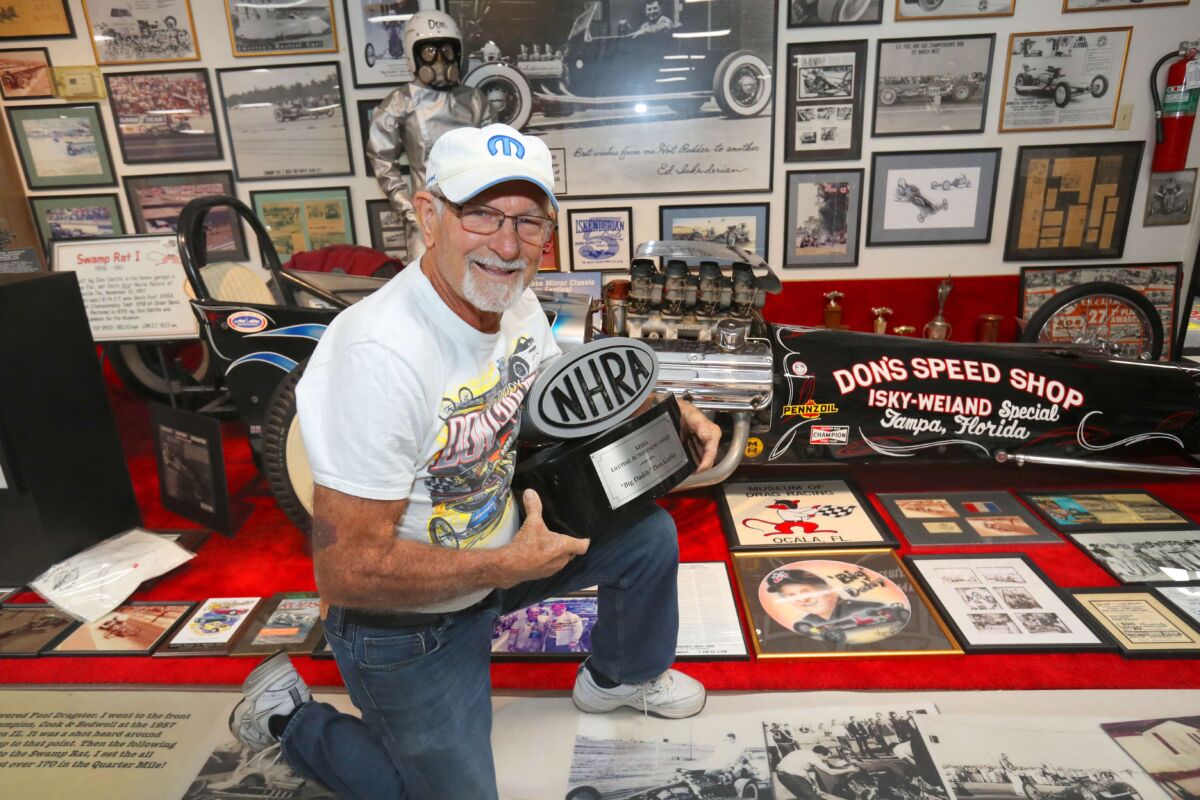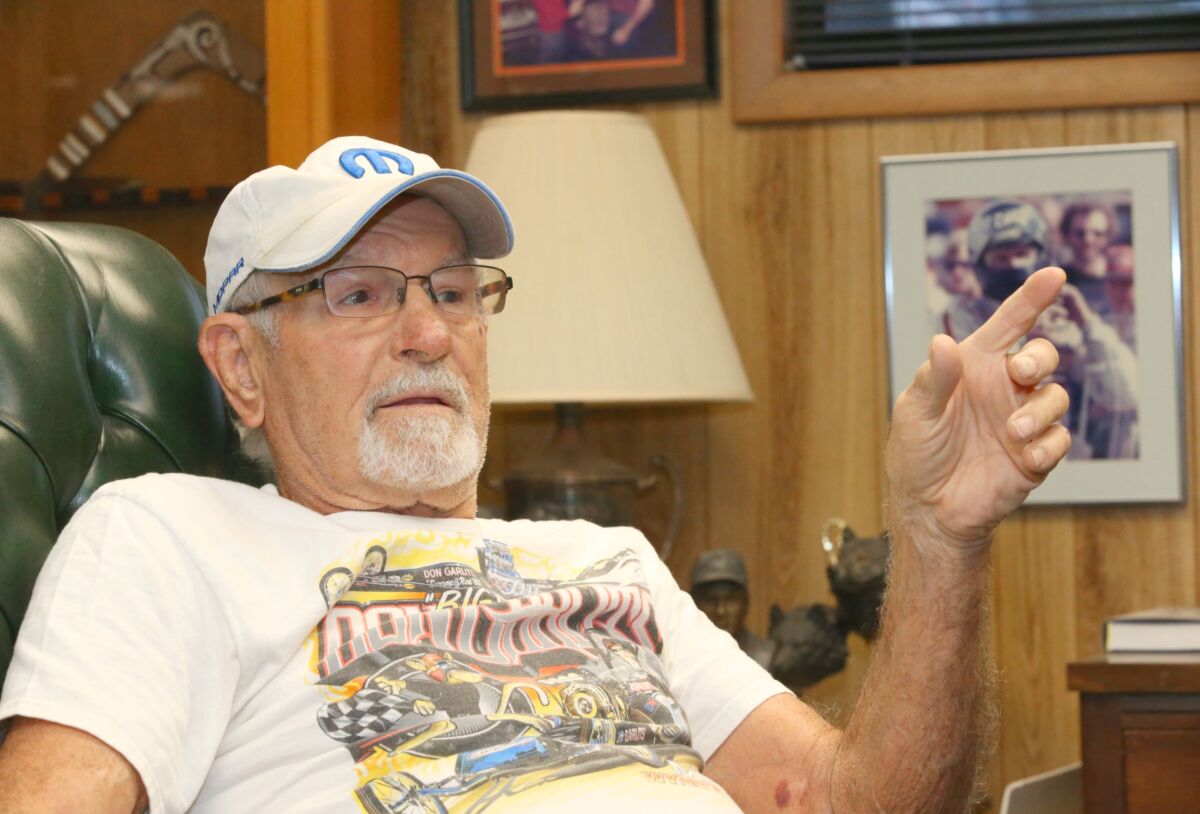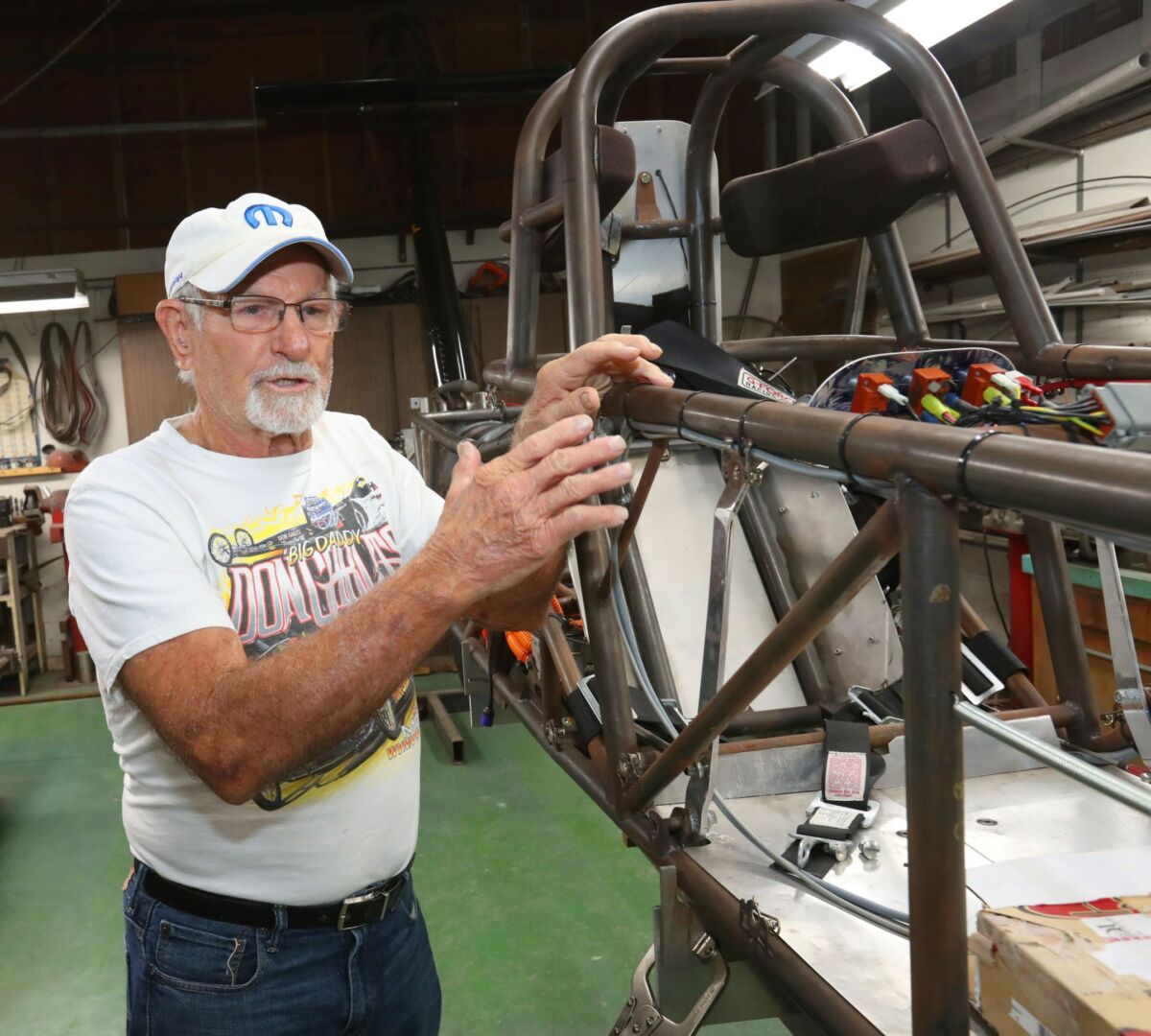“Big Daddy” Don Garlits, one of the winningest drag racers of all time, has no plans to slow down as he turns 90 years old.

Drag racing legend “Big Daddy” Don Garlits poses with his NHRA Lifetime Achievement Award in front of Swamp Rat I (1956-1961), his first World Record drag racing car, at the Don Garlits Museum of Drag Racing south of Ocala, Fla. on Tuesday, Dec. 21, 2021. [Bruce Ackerman/Ocala Gazette] 2021.
In late December, he was refining his new battery-powered electric dragster, with plans to do some “test and tune” runs in January in south Florida with an eye toward setting a new speed record during the National Hot Rod Association (NHRA) Gatornationals in Gainesville from March 10-13.
Garlits, known as the father of drag racing, is a pioneer who has designed numerous remarkable racing vehicles, engineered life-saving safety technology, established a long list of speed and timing records and set a high standard of excellence in his professional and personal life.
He established the Don Garlits Museum of Drag Racing south of Ocala in 1976. The sprawling campus includes two massive buildings that house an astonishing collection of vehicles and memorabilia, along with outbuildings in which Garlits still builds his Swamp Rat racers. The museum also is the home of the International Drag Racing Hall of Fame.
NHRA has called Garlits the greatest driver in its history. He is one of the International Hot Rod Association’s career leaders. Awards, including one for lifetime achievement, bestowed by the NHRA in 2018, fill his office and the museum. He has won thousands of races, including the highest-level championship events in the sport, achieving speeds up to 323 mph.
In 1989, he was inducted into the Motorsports Hall of Fame of America, in 1997 into the International Motorsports Hall of Fame, in 2004 into the Automotive Hall of Fame and in 2014 into the British Drag Racing Hall of Fame.
The still lithe automotive guru with gnarled hands and a toothy grin remains eager to talk about his sport, his family and his burning desire to keep doing what he loves. A bout with the coronavirus in the fall “did a number” on him, but he has bounced back with the impressive energy that has sustained him for nine decades.
The Gazette visited Garlits at the museum recently for a lengthy interview and behind-the-scenes look at what he’s working on now. So, pull up a comfortable chair or a shop stool and settle in while we do a little “bench racing” with one of the greatest gear heads of all time.
Family Ties
Donald Glenn Garlits was born in Tampa. He was working on cars under oak trees in his teens, swapping motors and transmissions and other parts to create roadsters and, eventually, “rail-job” dragsters.
He was a good student and served as captain of his school’s bookkeeping team, which won a state championship.
“I got my pick of jobs,” he recalled. “I had a real good job at Maas Brothers in downtown Tampa as an accountant. I had worked with my stepfather on his dairy for eight years and one day he said, ‘I can see you’re not happy in your new job.’ I said look at my nice clean shirt and my tie. I’m even making more money than you. He said, ‘Don, money isn’t everything. You love cars and that’s what you should be in.’ I said Mom thinks car mechanics are grease monkeys. He said ‘Your mother isn’t going to live your life. If you do what you love, you’ll be successful because you’ll spend so much more time at it.’”
His fate was sealed not long after that, when, at age 20, he met the girl of his dreams, Patricia Louise “Pat” Bieger. When he drove his hot rod Ford with a Cadillac engine to meet her parents, it didn’t go so well. He traded the cool car for a “plain Jane” 1950 Ford, which met with her father’s approval. It wasn’t long before the two were married.
One day they went on a picnic to Bok Tower and stumbled across a nearby airport that had a drag strip. He entered the Ford and won his class. He said it was a family atmosphere, which Pat really liked and, all of a sudden, he was back into racing, with her full support. He said that support continued throughout his career, even as they became a family with the births of daughters Donna and GayLyn.
Pat Garlits passed away from complications of Parkinson’s disease in 2014.

Drag racing legend “Big Daddy” Don Garlits reminisces about his long drag racing career in the NHRA at the Don Garlits Museum of Drag Racing south of Ocala, Fla. on Tuesday, Dec. 21, 2021. [Bruce Ackerman/Ocala Gazette] 2021.
Donna Garlits said her parents instilled in their children that you don’t say you’re going to do something unless you mean to carry it out.
“He taught me that determination leads to success. He was a self-made man. He didn’t have a college background. He learned by doing and by studying. He always had his nose in a book. At night after dinner, he wasn’t in front of the television, he was out in the shop creating something,” she said.
“I learned by his example,” she added. “He taught you integrity and honesty because that’s what he is, a man who believes your word is your bond. There was a work ethic in our home, and perfectionism and a competitive nature, and that was the drive that caused GayLyn and I both to be very driven to be the best we could be at whatever we did.”
Donna, who has two children, has excelled in business, including running the racing museum for a time as well as being a gifted math tutor whose at-risk students consistently achieved top honors under her guidance. She recently helped nurse her father through COVID-19, which he had at the same time as his parter, Lisa Crigar.
“Donna was here for two months while I had the coronavirus. She took care of me. Lisa had it too. With me it was death defying,” he stated “I went through about seven days of really touch and go where I felt like at any time I could die. I just prayed a lot and talked to God. I said, it’s your choice Lord, if you want me to stay here, if you’ve still got work for me, fine, if you want me over on the other side, that’s fine too. He’s left me here so, evidently, I’ve got something more to do. I’m so blessed to have made it.”
GayLyn Garlits Capitano is a concert pianist, owner of Capitano Music Studio and adjunct professor of piano at the College of Central Florida. She and her husband, Greg, have three children.
“Dad has taught me, most importantly, to love and trust in Jesus and to get on my knees to seek God’s will,” she said. “I have seen miracle after miracle as Dad has done this. Dad has taught me to value family and hard work and to be refreshed by God’s beautiful creation.”
She said she has fond memories as a child of traveling the U.S. and other countries watching him “conquer the racing world.”
“Dad loves his children and grandchildren and loves to have them with him. He has always supported and encouraged us to pursue and develop our gifts and passions and to use them for God’s glory. We are all so thankful for Dad’s 90 years and that he survived COVID. We are proud of his amazing accomplishments and inspired by him daily. We love him dearly,” she said.
Capitano said when she was about 12 years old, she entered a piano competition against high school-age students.
“Dad told me if I won, he’d buy me a Steinway. He had to do that. And that piano is such an inspiration, even today,” she noted. “Dad took piano lessons for two years because he wanted to learn what I was doing. He’s the father of drag racing and he also is a wonderful father.”
Donna said she believes one reason her father survived the coronavirus is “because he has taken such good care of himself all his life.”
“He has always eaten well, taken nutrients, supplements… both of my parents were like that,” she said. “We had organic gardens growing up and his dad was an advocate for healthy eating. He was one of the first guys to open a health food store, in New Jersey, back in the ‘20s and ‘30s. Dad grew up with that ingrained in him. Plus, he stays active. He is not going to be on the front porch in a rocking chair waiting for life to end. And that’s the key. He loves his life and what he does and his mind is always turning.”
In recent years, Don Garlits earned his real estate license and “got into flipping houses. I completely gutted a house from the ‘60s on Lake Henderson. Tore everything out of it put all new configuration in it and it’s just about finished.”
“Even after he was getting well from COVID, he had me out there helping him hang a door, all kinds of stuff,” Donna said. “I came home and rewired a lamp that had not worked for years and redid the faucet in my kitchen sink because Dad had showed me how to do it. He is amazing.”
Chuck Keppel, comptroller and general manager of the museum, and Garlits’ nephew, said his “Uncle Don” still acts like a teenager.
“He’s constantly on the go. He’s always working on something. I hope I have that much energy when I’m 90 years old,” Keppel said.
Keppel said the museum is doing well and that attendance has continued to grow.
“We still have people coming through. They’ll be here multiple times and say ‘I didn’t see that the last time.’ We recommend at least a couple of hours to walk through both buildings, but you have those drag racing fans who will be here all day because there is so much in here. And we have people walk in and say, ‘I’ve got this photo of you,’ and Uncle Don can tell you the place, the date. At 90 years old he remembers it.”
“The museum is doing wonderful,” Don Garlits said. “We only had two months of bad times when we had to close because of the coronavirus but as soon as we opened back up, the very first month we were in the black. I’m really happy about this place and it is another reason I tell people, ‘Do what you love. Put everything into it.’”

Drag racing legend “Big Daddy” Don Garlits talks about Swamp Rat 38b, his newest, electric dragster that is being built by Chis Bumpus in Don’s Garage at the Don Garlits Museum of Drag Racing south of Ocala, Fla. on Tuesday, Dec. 21, 2021. [Bruce Ackerman/Ocala Gazette] 2021.
Garlits was severely burned and lost part of one foot when the front-motor Swamp Rat XIII exploded in 1970. After a long convalescence, he perfected the rear-engine top fuel dragster that remains the standard today.
As one testament to his pioneering designs and engineering skills, his Swamp Rat XXX is in the Smithsonian’s National Museum of American History. It was the first top fuel dragster to combine a rear engine, streamlined body and enclosed canopy cockpit. In that car, he set a record speed of 272.56 mph during the 1986 Gatornationals and won the 1986 NHRA World Championship (which he also won in ’75 and ’85).
Garlits said that as his top fuel cars kept getting faster and faster, Pat told him she was frightened for him.
“I quit driving a top fuel dragster because she asked me to. She said it was scaring her,” he said.
But that didn’t end his racing career by any stretch.
“In 2008, Chrysler folks called and said they were going to build two prototype Drag Pak cars and would I like to test one for them,” he recalled.
The V8 Mopar Dodge Challenger Drag Pak, the company’s first drag race, factory-prepped package cars in 40 years, included suspension and chassis upgrades for NHRA and National Muscle Car Association competition.
“I flew to Denver and Judy Lilly, Miss Mopar, and I tested them. I came home and my wife asked how I liked it and I said it was really fun driving the thing and getting back on the drag strip, and she said, ‘Well why don’t you get one?’ I said I thought it scared you and she said, ‘You in a 135 mph car is like walking; it’s 300 mph that scares me.’ So, I got Number 1 and had a lot of fun with it. Then they came out with the V10 and I ran that a for short period of time and then Pat got much sicker, so I was sticking around her pretty much.”
“In the meantime, we had done a fundraiser for Darrell Gwynn (also one of the sport’s top drivers, who was paralyzed following a crash in 1990) and presented him with an electric car that looked like a dragster,” Garlits said. “They gave it to him in at Indy (the NHRA U.S. Nationals) in 2001. The people went wild.”
“About a month later,” Garlits continued, “Darrell said why don’t we build a couple of those cars, one like your car in the Smithsonian and one like my car that I competed against you for the world championship and raise money for spinal cord injury research. And I said that sounds like fun.”
Their series of Garlits vs. Gwynn: Match Races for a Cause helped raise money and awareness. The cars later were auctioned off to raise even more funding.
Garlits said he asked the guy who built those cars how fast they would go “If we took the gloves off?”
“He said 200 mph and I said let’s do it. And he built Swamp Rat XXXVII for me,” he added.
The speed record then was a little over 150 mph in the quarter mile, which Garlits soon pushed up to 185 mph.
“That car was built on a top fuel chassis and was heavy and the battery technology wasn’t as good as it is today, so I built Swamp Rat XXXVIII and right off the bat I raised it to 189 mph on just a warm up run,” he said. “The next run was really on the way but a hub broke because the weld failed.”
Things had changed with his welding rod supplier, then the coronavirus came along and the batteries went bad from non-use.
“And, in 2020, Steve Huff from Spokane went 201 mph and so all the edge was taken off and I just backed off,” Garlits said.
But not for long.
“About three months ago,” he said grinning widely, “I found a motor that makes more power and I’m moving the drive system like I had in Swamp Rat XXXIV, with the narrow wheels and the mono wing, to the electric car. I think it should be good for 215 mph, in that range. We’ll be on the track in January and hopefully run in Gainesville and go 200 mph at the Gatornationals.”
Life Lesson
When asked how he would define the meaning of life, Garlits said he believes it is that we are here to learn how to live with other human beings peaceably.
“In other words, when somebody does something mean to you, return it with something nice and sweet. Nothing disarms anger like goodness. If somebody does something really bad to you, pray for them,” he said.
He said he had a true example of how this can work, then talked about some fellow racers asking to use the shop he shared in 1960 in Tampa with Connie Swingle. He said they needed to stay late and so he left them in the shop and went home. The next morning, he found the shop locked up but two expensive gauges were missing from his and Swingle’s expensive new cutting machine.
“Those gauges were $500 apiece. We lost $1,000 worth of gauges that we were going to have to special order. Swingle flew into a rage,” he recalled. “I said you know God is vindictive. We did these guys a favor and God knows that. He might really hurt them over this. Let’s just say a little prayer for them that we know it was wrong but be easy on them, we’ll get more gauges, everything will be fine for us, but let’s make sure they don’t get put in a wheelchair or something over this because He don’t fool around. So, we did that.”
With the pitch of his voice rising, Garlits continued, “Five minutes later, my wife says Don there’s a phone call for you from Champion Spark Plug. They want to use you in an ad in all the major magazines and give you $5,000. And I told Swingle, see there, how quickly we were benefitted. It changed the way he thought about things. And that is the prime example of what you’re supposed to do.”
To learn more, visit garlits.com





